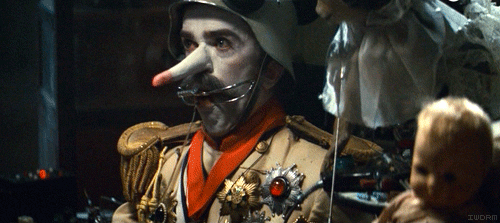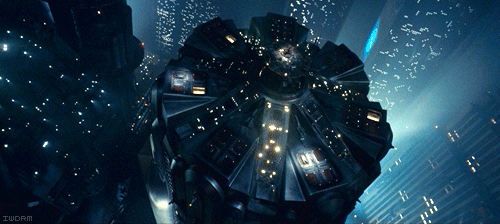“More human than human” is our motto.
The replicants in Blade Runner (Ridley Scott, 1982) live with a forced delineation between human and machine. They know they were created by humans and are painfully aware that their makers designed them to die after four mere years of existence. This is the foundation for the replicant Roy Batty’s at its core philosophical but also desperate and violent hunt for the scientist that can bestow him with life extension. As such, Batty confirms what the boss Bryant tells Deckard early in the plot, that replicants sooner or later develop human feelings, which is why they must be destroyed. The erratics of emotional behaviour is human but also lethal, while the replicants were always intended as working machines with well-defined tasks not to be explored beyond.
In a review of the various replicants Deckard is tasked to “retire” (meaning kill) they are classified, among other things, by function, like software written according to a specification. The murder replicant Zhora is described just like that: “Func: Retrained (9 Feb., 2018) Polit. Homicide” while Pris as an acrobatic seductress is labelled “Func: Military / Leisure”. But they are also assigned gender, fixed by the designers not only through a rather simplistic anatomic idea of physical attributes and vocal tone as determinants but also constructs such as names. All in all, the replicants are put into the binary gender construct, much like humans. Bryant reinforces that idea by describing Zhora as the archetypal femme fatale: “Talk about Beauty and the Beast – she’s both.”
The feeling of being a function in someone else’s machine, a kind of cyborg alienation, is pointed out by Batty when he and Pris visit the gene designer J. F. Sebastian in a robot-filled home. Sebastian finds out the visiting replicants are Nexus-6 types – a model he took part in designing himself – and wants Batty to “show him something”, share some example of his perfection. Batty replies with a bit of bitterness: “We’re no computers, Sebastian. We’re physical.” Pris concludes with Descartes’ classic statement cogito ergo sum, I think therefore I am. None of the two will survive their four years.

Interesting enough, Descartes commented on the relationship between human and machine already in 1637. He was rather sure that even if machines would be able to perform certain tasks equally well or better than humans, the machines would be eternally deprived the abilities of reasoning and deep understanding, their actions only the result of logical deduction. Batty’s philosophical and existential struggle and Pris’ Cartesian meta-comments appear to almost mock the old philosopher.
The truly compelling replicant is Rachael, only recently made aware of her cyborg “nature”. Early in the movie, we see Deckard perform the sequence of psychological tests that is supposed to expose replicants as such, on an already questioning Rachael. Only the technological genius Tyrell is at this point sure whether Rachael is a replicant or not since he created her. In terms of binary stability, Rachael is coded as a woman by appearance, but there is An ambivalence surrounding her sexuality is established when she with noticeable scorn refuses to answer a test question about a nude woman: “Is this testing whether I’m a replicant or a lesbian, Mr Deckard?” In this manner, Rachel analyses the analysis, avoiding to be placed on either side of the either/or sexuality invented by humans. We discern a cyborg leakage, a Harawayian tendency towards transgression, especially if Rachael is to be taken literally in that being a replicant and a lesbian are mutually exclusive. The replicant/cyborg does not have a sexuality in the humanly hegemonic sense.
Herein lies an interesting parallel with the term “homosexuality” within the US military, where there have been attempts to not only regulate (and minimise) homosexuality but also to get rid of the word itself. Laws have been proposed to outright ban it in descriptions and self-definitions used internally. Just like Deckard is on the hunt for cyborg behaviours through the tests, the military has hunted “inclination” towards homosexuality by surveying various “actions, gestures and nuances that all point in the same direction.”
Rachael’s way to answer the test question can be seen rather as a result of system logic, by extension of her designer’s source code. Stable sexuality might be impractical for the system as a whole (the replicant population) and if nothing else highly irrational according to Haraway’s view on sexual reproduction:
Ideologies of sexual reproduction can no longer reasonably call on notions of sex and sex role as organic aspects in natural objects like organisms and families. Such reasoning will be unmasked as irrational […]
This sexual ambivalence later develops as Rachael visits Deckard after saving his life from the psychotic replicant Leon. She is coming to terms with the fact that she is a replicant. (Which Deckard unknowingly is too, made clear to different extents in the different versions of Blade Runner.) In a moment of self-objectifying clarity, Rachael points out: “I’m not in the business… I am the business.” She is a non-human, made as a tool, but carries a whole other experience.
When Deckard falls asleep, Rachael sits down at his piano and examines the photos that cover it. There are pictures of women we will never get to know, presumably family members. Rachael herself has had all her memories implanted (based on the creator Tyrell’s younger relative) and thus has no real background, maybe this is the source of her fascination with Deckard’s photographs. Based on one of the pictures, in a gesture of classic conditioning of femininity, Rachael lets our her hair and strikes a few chords on the piano. Stiffly stylised hair, broad shoulders, and robotic posture are replaced by meandering curls, white and sheer attire, and soft sentimentality. One interpretation is that she mentally and physically becomes a “real” woman, the action is performative and fixates the category. Deckard soon awakes and it is not until now, when Rachael has “become a woman”, that he makes any sexual advances. But the reaction is complete indifference, with a long and empty glance locked in the distance Rachael is motionless, to then make a run for the exit. She is blocked by Deckard who carries out what can only be described as an assault but under strange cybernetic forms. Like a programmer Deckard runs commands (“kiss me”) that Rachael answers automatically, performing logical control of femininity as a replicant, while Deckard exercises male dominance. Two replicants performing human roles.
There is a confusion to Rachael’s reactions, not in terms of consent, but rather the recoil at what is fundamentally foreign. The replicant Batty’s mentioned feeling of alienation, to be a cog, is found in Rachael as she is drastically placed in the role as a sexual function. The ambiguous emotional response is according to Haraway at the core of cyborghood:
The replicant [Rachael] in the Ridley Scott film Blade Runner stands as the image of a cyborg culture’s fear, love, and confusion.
(The illustrations are from the lovely project If we don’t, remember me.)

